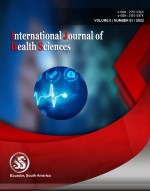Pregnancy outcomes in COVID positive patients
Keywords:
COVID-19, fetus-maternal outcome, positive patients, pregnancy, vertical transmissionAbstract
Background and Objective: A new pathogen of high contagious abilities named Corona virus was seen to target pregnant women due to physiologic changes in their immune system, cardiopulmonary and coagulation system leading to poor fetus-maternal outcome. Thus, to determine maternal and fetal outcome in pregnant women affected with COVID-19 and its frequency of vertical transmission is the main objective of the study. Methods: This is a prospective study of 50 pregnant women with RTPCR confirmed COVID-19 infection between 1st March 2021 and 1st August 2021. The foetal and maternal outcome, frequency of vertical transmission, mode of delivery, presenting symptoms and Level of serum markers such as LDH and CRP were noted. Results: Among 50 patients, 68% delivered through Caesarean section 34% delivered vaginally. The most common presenting symptom was fever in 50% patients. Other symptoms were running nose, headache, myalgia, loss of smell and taste.68% patients had raised Serum LDH level and 26% patient had raised Serum CRP level. The maternal condition was taken into account based on source of oxygen saturation by monitoring Spo2 level.
Downloads
References
World Health Organization. Coronavirus disease (COVID-19) pandemic. Available online at:
https://www.who.int/emergencies/diseases/novel- Corona virus -2019t. Last accessed on February 17, 2020).
Alserehi H, Wah G, Alshukairi A, Alraddadi B. Impact of Middle East Respiratory Syndrome Coronavirus (MERS-CoV) on pregnancy and perinatal outcome. BMC Infect Dis. 2016; 16(5): 105-10.
Lam CM, Wong SF, Leung TN, Chow KM, Yu WC, Wong TY, et al. A case-controlled study comparing clinical course and outcomes of pregnant and non-pregnant women with severe acute respiratory syndrome. BJOG. 2004; 111 (8): 771-4.
Alfaraj SH, Al-Tawfiq JA, Memish ZA. Middle East Respiratory Syndrome Coronavirus (MERS-CoV) infection during pregnancy: report of two cases & review of the literature. J Microbiology Immunology Infect. 2019; 52 (3): 501-3.
Huang C, Wang Y, Li X, Ren Zhao J, Hu Y et al. Clinical features of patients infected with 2019 novelCoronavirus in Wuhan, China. Lancet. 2020; 395 (10223): 497-506.
6 . Jeong SY, Sung SI, Sung J, Ahn SY, Kang ES, Chang YS, et al. MERS-CoV infection in a pregnant woman in Korea.J Korean Med Sci. 2017; 32 (10): 1717-20.
Chen N, Zhou M, Dong X, Qu J, Gong F, Han Y, et al. Epidemiological and clinical characteristics of 99 cases of 2019 novel Coronavirus pneumonia in Wuhan, China: a descriptive study. Lancet. 2020; 395(10223): 507-13.
Chen S, Huang B, Luo DJ, Li X, Yang F, Zhao Y, et al.
Pregnant women with new Coronavirus infection: a clinical characteristics and placental pathological analysis of three cases. Zhonghua Bing Li XueZaZhi.
Chen H, Guo J, Wang C, Luo F, Yu X, Zhang W, et al. Clinical characteristics and intrauterine verticaltransmission potential ofCOVID-19 infection in nine pregnant women: a retrospective review of medical records. The Lancet. 2020: 395 r102261: 809-15.
Schwartz DA. An analysis of 38 pregnant women with 2 COVID-19, their newborn infants, and maternal fetal transmission of SARS-CoV-2: maternal Coronavirus infections and pregnancy
outcomes. Arch Pathology Lab Med. 2020; 5858/arpa.2020-0901-5A.
11 .ZenX H, Xu C. Fan J, et al. Antibodies in in-fonts born to mothers with COVID- 1 9 pneumonia. JAMA 20ÿ32 3(IS):1845-9.
12. Done L, Tian J. Hc S, Zhu C, Wane J. Liu C. el al. Possible vertical transmission of SARSCov- 2 from an injected mother tohernewborn. JAMA 2020
13. World Health Organization. Frequently askedquestions: Breast-feeding and Covid 19 dated 12 may 2020. Available at https://www.who.int/docs/default-source/maternal-health/faqs-breastfeeding-and-covid-19.pdf?sfvrsn=d839e6c0_5. Accessed on 10th June 2020
Published
How to Cite
Issue
Section
Copyright (c) 2022 International journal of health sciences

This work is licensed under a Creative Commons Attribution-NonCommercial-NoDerivatives 4.0 International License.
Articles published in the International Journal of Health Sciences (IJHS) are available under Creative Commons Attribution Non-Commercial No Derivatives Licence (CC BY-NC-ND 4.0). Authors retain copyright in their work and grant IJHS right of first publication under CC BY-NC-ND 4.0. Users have the right to read, download, copy, distribute, print, search, or link to the full texts of articles in this journal, and to use them for any other lawful purpose.
Articles published in IJHS can be copied, communicated and shared in their published form for non-commercial purposes provided full attribution is given to the author and the journal. Authors are able to enter into separate, additional contractual arrangements for the non-exclusive distribution of the journal's published version of the work (e.g., post it to an institutional repository or publish it in a book), with an acknowledgment of its initial publication in this journal.
This copyright notice applies to articles published in IJHS volumes 4 onwards. Please read about the copyright notices for previous volumes under Journal History.
















